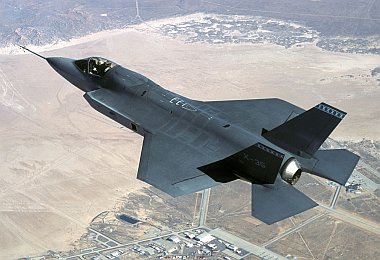
Boeing, Northrop Grumman, General Electric and Raytheon's FA-18 Super Hornet (above) and Lockheed Martin, BAE Systems and Northrop Grumman's F-35 Joint Strike Fighter (below).

Govt spends $6b on 'stop-gap' fighter-bombers
Australia will spend $6 billion to buy 24 advanced Boeing Super Hornet fighter-bombers as a stop-gap measure so the RAAF can maintain regional air superiority until new Joint Strike Fighters are built.
The decision spells the end of the F-111 strike bombers which will be retired, most likely without ever having dropped a bomb in anger, in 2010.
[These 24 stop-gap aircraft will cost $6 billion, or $250 million each.]
FLASHBACK: RAAF 'won't need' interim jet
October 10, 2006
The deputy chief of the air force, Air Vice Marshal John Blackburn, said defence remained confident the F-35 would be delivered on time, with the first squadron scheduled to be blasting through Australian skies by 2014.
Main course: 100 Lockheed F-35 Lightening JSFs ordered
As a result of a 1995 Memorandum of Understanding, Australia is contributing US$144 million to the F-35 JSF project.
A total price tag of $12b means the unit price is about $120m each.
However, the joint strike fighter, conceived as a versatile and affordable fighter for the US and its allies, continues to be plagued by rising costs that have boosted the per-unit US government report released Thursday.
Some critics say the F-22 or the Eurofighter may be better choices, both offering better range, dogfighting capability, and supercruise at a cost that may not be much more than the F-35 — claims that as of July 2006 are being examined in a parliamentary inquiry.
Australian defense minister Brendan Nelson has reportedly decided to opt for the Super Hornet without a detailed study of alternative aircraft types such as the longer-range F-15E Strike Eagle, or more advanced air superiority options such as the Eurofighter Typhoon. Despite its name, the Super Hornet is a larger aircraft that offers only 25% to 30% commonality with the Australian Air Force's existing Hornets; it does, however, share the same support structure.
[Geoff Elliot Troubled stealth fighter tackles first test flight]


No comments:
Post a Comment